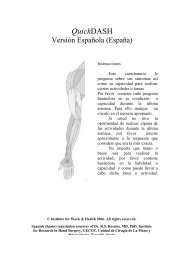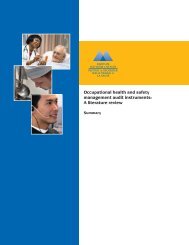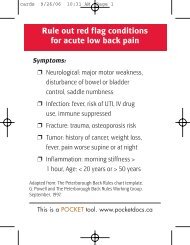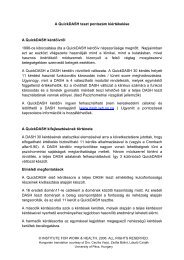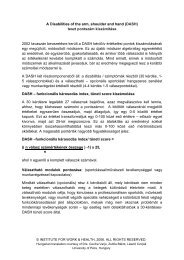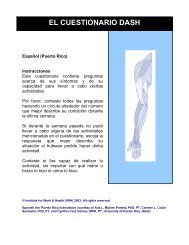A systematic review of injury/illness prevention and loss control ...
A systematic review of injury/illness prevention and loss control ...
A systematic review of injury/illness prevention and loss control ...
- No tags were found...
Create successful ePaper yourself
Turn your PDF publications into a flip-book with our unique Google optimized e-Paper software.
YesNo24. Does the study use clinical diagnosis or physical exams to collect measurements <strong>of</strong><strong>injury</strong>/<strong>illness</strong> outcomes?Describe succinctly in the comment box the protocol or type <strong>of</strong> exam.YesNo25. Was the population studied “fixed” or “open” (check all that apply)?A “fixed” population is one where the population is fixed at some time <strong>and</strong> the sameparticipants are followed over time. An open population is where individuals can come in<strong>and</strong> out <strong>of</strong> the study. In a worksite population, the intervention happens at some point <strong>and</strong>different individuals can contribute information before <strong>and</strong> after the intervention (new hires).In most cases the population will be either fixed or open. However in a small number <strong>of</strong>studies it may be that a fixed cohort is drawn from a larger open population study.Fixed PopulationOpen PopulationUnclear“Administrative” Record Questions26. What sources were used to “count” employee injuries (check all that apply)?Regulatory required employer record keeping data (e.g., OSHA logs)Voluntary employer record keeping data (e.g., incident reports)Insurance record keeping systems (e.g., workers’ compensation claims data)27. How were employee hours collected (check one only)?Many studies calculate <strong>injury</strong> rates for a unit or an organization. A critical piece to thecalculation is the collecting employee hours. Estimations <strong>of</strong> employee hours by calculatingfrom the number <strong>of</strong> employees are very different from getting actual employee billed hours.Estimation <strong>of</strong> employee hours worked from an estimated <strong>of</strong> number <strong>of</strong> employeesEstimation <strong>of</strong> employee hours worked from an actual number <strong>of</strong> employeesActual employee hours from a specific number <strong>of</strong> employeesEmployee hours not collectedUnclear (please describe)28. Indicate at what level employee hours were ascertained <strong>and</strong>/or estimated.IndividualUnitSite80 Institute for Work & Health



